The Vienna Philharmonic keeps the pulse of the Salzburg Festival

Year after year, the true heroes and heroines of the Salzburg Festival are the Vienna Philharmonic musicians, for whom the epithet "multi-employed" seems a far cry. On Saturday, for example, the performance of Macbeth , in which they played, concluded. It was just after ten at night. On Sunday, at eleven in the morning, they offered a symphonic concert, also at the Grosses Festspielhaus. By three-thirty, they were once again occupying the pit, this time the Felsenreitschule pit, to play in the show entitled One Morning Turns into an Eternity . And well before the latter began, more than half the orchestra—including their concertmaster, Albena Danailova—was already in the pit, reviewing passages at their music stands. It's true that, accustomed to playing daily at their hometown's Staatsoper, without having to give up concerts and tours, they have a large roster that allows them to rotate so as not to burden themselves with more hours than necessary. Even so, their multi-tasking, and with different conductors on the podium, cannot help but amaze.
At the symphony concert, they showed off their finest (with a 16/14/12/10/8 distribution in the string section, which was dwarfed by the colossal dimensions of the Grosses Festspielhaus stage) and presented a highly original program featuring the Tenth Symphonies of Gustav Mahler and Dmitri Shostakovich, so different in every way. With these, both composers crossed the almost forbidden threshold left by Beethoven, the main reference for all subsequent symphonists. The former's, however, remained incomplete, while the performance of his fervent Soviet admirer represented, after Stalin's death, the closest thing to an act of self-affirmation, most clearly demonstrated by the repeated use of the musical anagram of his first and last name (DSCH, i.e., D-E-B-C).
Mahler's music is full of doubts, meanders, and possible paths to tread for the first time. After a fiercely dissonant climax, the coda slowly and inevitably disintegrates into nothingness. Shostakovich's Tenth displays Beethovenian styles and mannerisms, albeit adapted to the composer's peculiar idiosyncrasies. He closes the first movement with his characteristic two-part counterpoint (in this case, surprisingly, for two piccolos). The third movement begins with a solo string and closes with its musical anagram played at the octave by flute and piccolo. Veterans Wolfgang Breinschmid and Günter Federsel (about to retire after having dedicated half their lives to this orchestra), both on piccolo , gave their umpteenth lesson in intonation, musicianship, and breath control, supported by the formidable Walter Auer and his wooden flute.
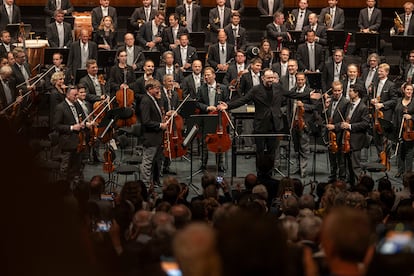
Andris Nelsons conducted works by two composers to whom he dedicated separate solo festivals in Leipzig ( in 2023 and this year ) at the head of the Gewandhaus Orchestra, of which he is principal conductor. He feels a close relationship with both (with Shostakovich, having grown up in a Latvia that was still Soviet) and has a very clear understanding of their stylistic evolution. In Mahler's Tenth, it is essential to carefully grade the tensions and know how to leave the music harmonically suspended, right from the initial solo of the violas (which he had bow en masse at the end). Nelsons always does this with plasticity and a global sense of form, without being carried away by easy starts or, much less, by sensationalism. The same is true of Shostakovich, although here the rapid passages (such as the cavalcade in the second movement, driven, as so often in his works, by the relentless succession of anapestic designs) require a different kind of conducting, in which Nelsons uses his whole body, bending and stretching, gathering and unfolding, to convey his intentions.
At the other extreme, in the more intimate passages or solos (all glorious in the second movement, like those of the bassoon, horn, flute, and English horn), his eagerness to draw out the phrases leads him to hide his baton—inverted—in his left hand and concentrate on capturing their ascents and descents almost with care. The orchestra gets on very well with him (they already chose him in 2020 for their eventful tour with Beethoven's nine symphonies ) and he proved to be in enviable form, despite the hustle and bustle of Salzburg. At the end, in the prolonged applause, Nelsons was, as always, a paragon of modesty and humility, deriving all the credit from his musicians. It was impossible to listen to this concert without remembering the music critic Pedro González Mira, who died in a Madrid hospital just hours before it began. He left us with insightful and highly personal reflections on both composers, especially on Shostakovich in his book, *The Musicians of Stalin* . He will be deeply missed by those of us who loved and admired him.
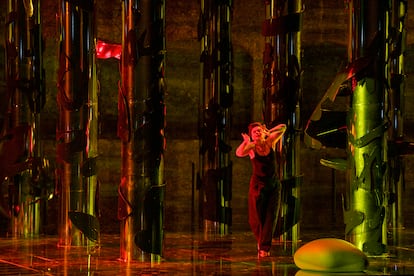
A few hours later, now under the baton of Esa-Pekka Salonen, who had already conducted Stravinsky's Oedipus Rex a few days earlier, the Vienna Philharmonic settled into the neighbouring Felsenreitschule, an even grander space, to take part in the aforementioned show: One Morning Turns into an Eternity . Its ideologist, Peter Sellars , with a long-standing connection to the Salzburg Festival, proposed a sequence consisting of Schoenberg's monodrama Erwartung and the last movement of Mahler's Song of the Earth , works that were practically contemporaneous with the somewhat later Five Pieces for Orchestra, Op. 10, by Anton Webern, who idolised both, as an interlude or connecting link. It is well known that Schoenberg sanctified Mahler after his death, and however different their scores may be, it always makes sense for them to be part of the same program. What is less clear is whether they can share the same dramaturgy, if any, in the American's evanescent proposal, which differs very little, if at all, from a concert version with a sparse stage set dominated by large, rotating silver columns wrapped in what could be black Chinese letters, perhaps alluding to the poems that inspired Mahler for his symphony in song form and which serve both to imagine the menacing nocturnal forest of Erwartung and to metaphorize the omnipresent nature in Das Lied von der Erde.
Ausřinė Stundytė, an exceptional actress, as she demonstrated in Madrid in performances of Prokofiev's The Fiery Angel , goes to extraordinary lengths to justify that we are witnessing something similar to an opera, however short its duration, and her dedication and her deployment of stage resources are such that she almost manages to convince us. Vocally, the nameless woman who stars in what Theodor W. Adorno brilliantly and accurately defined as “the seismographic record of a traumatic shock ” that, “at the same time, becomes the technical-formal law of music,” obtains a perfect translation by the Lithuanian soprano. Schoenberg himself, in what was his first large-scale atonal experiment, chose to write unstructured, athematic, free music, stripped of tonal centers, removed from any classical formal procedure, written point-blank as a long recitative accompanied by a clear orchestral polyphony with the aim of "representing in slow motion everything that happens during a single second of maximum spiritual agitation, stretching it to half an hour."

Sellars avoids all mystery even before the music starts, when two workers carry what appears to be a corpse wrapped in a black plastic bag and place it at the woman's feet, making her sign a receipt: nothing like, therefore, the domestic and much more ambiguous proposal directed by Christof Loy at the Teatro Real in Madrid. Numerous lighting changes and the turning of columns are practically the only changes on stage, so everything is left to the artistry of the Lithuanian soprano, who with perfect diction, a powerful and well-projected voice, and feline movements around the stage, keeps our attention, but without completely dispelling our doubts about the true nature of what she is proposing. Webern's interlude serves to confirm how far he managed to depart from his maestro's style and contains—not coincidentally—parts for celesta, mandolin, and guitar (undoubtedly influenced by Mahler's Seventh Symphony and Das Lied von der Erde ). It was a good idea to place two percussionists (xylophone and bells) high up, to the right of the stage, in order to broaden our spatial perspective and shake us out of a certain lethargy.
Fleur Barron replaced the announced Wiebke Lehmkuhl shortly before the premiere, who had to cancel her participation for family reasons. She performed Der Abschied , the grandiose Lied that concludes The Song of the Earth , with a much more static attitude, forced because there is no action here (not even mental), but rather a long reflection on transcendence and on the constant regeneration of life according to the course of the seasons. Any sensitive ear will also detect all kinds of kinship between Der Abschied and Isolde's final death, both crowned by an atmosphere of transfiguration. In her unexpected debut in Salzburg, Barron, who had already had a distinguished participation at the Mahler Festival in Amsterdam in May, sang her part very well, although after her partner's performance, her (limited) movements on stage seemed more artificial and far-fetched. In the pit, Salonen opted for his usual analytical and precise approach, very much in the vein of Pierre Boulez, without ever revealing any raw emotions, not even in that succession of " ewig " (eternally) that can melt hearts of ice. As both parts demonstrated in Messiaen's Turangalîla Symphony , which they performed at the Lucerne Festival three years ago, the Finn gets along well with the Viennese, who must appreciate the clarity of his gestures and the absolute mastery he demonstrates with the score. But nothing was particularly moving: rather, it all seemed like a brief, vaguely orientalist and spiritualist caprice – a little over an hour long – by Sellars, a postmodern pope, very much in the vein of The Doe with Nine Jewels , which was seen this summer at the Aix-en-Provence Festival: incidentally, the composer of part of its music, the Israeli Sivan Eldar, was sitting next to him in the stalls.
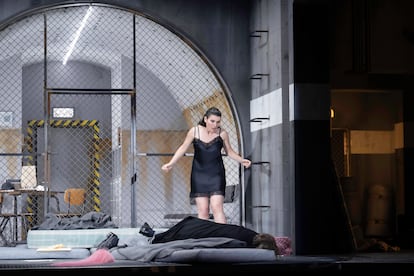
Another strong bet of this year's festival is a new production of Giulio Cesare , Handel's most performed opera in modern times. The fearsome Dmitri Cherniakov, who has accumulated major flops ( the new Ring from the Berlin Staatsoper or the terrifying Così fan tutte from Aix-en-Provence, among many others) and undeniable successes ( The Legend of Tsar Saltan , seen this season at the Teatro Real in Madrid, a paragon of sensitivity and intelligence), was in charge of the staging. As is almost always the case when he moves away from bourgeois sets and conflicts – a fixation of the Moscow director – his proposal is interesting. His Giulio Cesare takes place entirely in what we imagine to be an underground bunker in times of war and, to set the mood, the performance begins with an explosion, siren sounds, the abrupt lighting of the room and the projection of large red subtitles informing us of the emergency situation (the latter will be projected again unnecessarily on several occasions throughout the show).
The three spaces in the bunker are used to position the characters in groups from the outset: Cornelia and Sesto, Cesare and Curio, the two Roman couples; and Cleopatra, Ptolemy, Achilla, and Nirenus, the Egyptians. All of them almost always appear on stage, although on many occasions they shouldn't be where they are so as not to openly contradict the dramaturgy: Cleopatra, for example, shouldn't see Pompeo's corpse at the beginning. Nor, on reflection, are some appearances (or disappearances) easily understood in a bunker where it seems impossible to enter or exit and where the characters seem condemned to live huis clos. But, all in all, Tcherniakov's proposal works, better in the second part than in the first, since the singers struggle to enter the theatrical game and not all possess the same acting skills. The Russian handles very well the moment when “ Parnaso dawns” in the second scene of the second act and the instrumentalists appear as if by magic on high, above the bunker, to play a “ vague Sinfonia di varj Stromenti ”. Also of dramatic power are Tolomeo's aria in the second act ( Sì spietata il tuo rigore ), during which he undresses Cornelia almost by shoving her, or the insinuations of a complex relationship between her and her son, Sesto, who rejects his mother's incestuous advances in Figlio non è . The same can be said of the scene in which Cleopatra, desolate, curls up on the ground and hides under the same blanket that had shortly before covered the supposed corpse of Cesare (he had plotted a fake death with Curio after being shot by the tribune) and which is unfailingly reminiscent of when Isolde puts on the shirt of Tristan, already dead, at the end of her production of Wagner's drama for the Berlin State Opera.
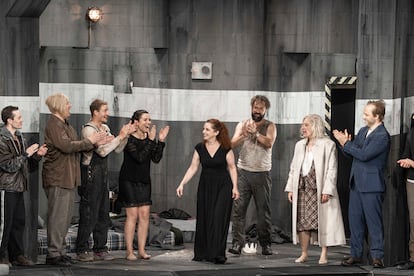
But the one who captures our attention from the very beginning is Olga Kulchynska, whom Tcherniakov presents from the outset as a snobby Cleopatra, with a long pink wig and cheap clothes, displaying a certain comic or vulgar quality that does not fit well with the character, although the Ukrainian soprano even manages to make her believable. After her transformation into Lydia, the character gains momentum, and Kulchynska's portrayal of the woman in love is a marvel of interpretation, as everything she does is thrilling: due to her way of acting, with her rich body and facial language, and because it's hard to imagine how the character could be sung any better, whether in the most lyrical passages ( V'adoro pupille, Piangerò la sorte mia ) or the most virtuosic ( Non disperar, chi fa?, Da tempeste il legno infranto ), where she displays a solid technique that allows her to take great risks with the da capos and cadenzas. Absolutely everything this former winner of the Francisco Viñas Competition does is perfect and leaves us speechless. Her Cleopatra will surely mark one of the highlights of this edition of the festival.
At his side, Christophe Dumaux (who knows the role very well, having premiered Calixto Bieito's dull production in Zurich, which was seen this season at the Liceu in Barcelona ) draws a Giulio Cesare that is also very credible, but without even coming close to matching his partner's. His voice is not the most attractive in the world, but his technique is very reliable, and the French countertenor exudes courage and expressiveness. At his side, Federico Fiorio (Sesto) and Yuriy Mynenko (Tolomeo) display numerous acting and vocal shortcomings, the former lacking volume and the latter experiencing abrupt changes in tone. Andrei Zhilikhovsky's Achilla was much better, very convincingly acted, and Lucile Richardot's Cornelia was uneven. She didn't always know how to adapt her powerful but very problematic voice to her characters and didn't quite create a convincing Cornelia, partly due to Tcherniakov's shortcomings. Emmanuelle Haïm confirmed her status as an outstanding Handelian, first-rate. Before a very large orchestra (perhaps excessively so for a hall like the Haus für Mozart), she delivered a lesson in style, depth, vigor, and dialogue with the scene from beginning to end. Someone was heard to comment that her conducting had been boring, something that didn't happen at any point, unlike Tcherniakov's production, which featured some great insights, but was hampered by that monotonous bunker that on more than one occasion became an unnecessary straitjacket. All in all, in a performance that lasted almost four hours, we witnessed a very interesting Giulio Cesare on Monday, with a singer in a state of grace.
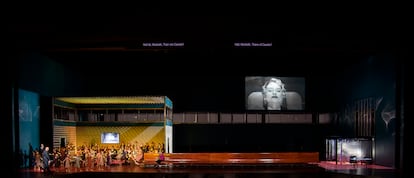
It's hard to understand what could have prompted the festival's directors to revive Krzysztof Warlikowski's production of Macbeth , which premiered here in 2023. Not only is there practically nothing of interest, but Verdi's great masterpiece reaches us seriously blurred with respect to what we know were the composer's original intentions (and, pointing out above, more than likely Shakespeare's). The Polish director makes his usual basic mistake: since he seems to lack confidence in the dramatic power of the original, he invents absurd parallel threads that only hinder, detract, and detract instead of—as, if we are being right-minded, one might imagine is their purpose—adding, explaining, or enriching.
From the outset, the stage design by his faithful Małgorzata Szczęśniak is a paragon of ugliness and inadequacy: the main characters always seem lost in the gigantic stage of the Grosses Festspielhaus, and the essence of the drama inevitably escapes in all directions. Warlikowski places the key to everything in the fact that Lady Macbeth is sterile (as shown with his usual childish didacticism in a gynecologist's office while the witches sing their first predictions) and the stage is populated by boys and girls dressed and masked as if they were adults, high heels included. It is also unclear what this space represents, halfway between a pelota court and a bus station, with a long wooden bench in the background that we already saw, mutatis mutandis, in his ill-fated Elektra. premiered here in 2020. What emerges from both sides—a prefabricated box housing the witches on the left and a sort of moving walkway with plastic walls on the right—is also decidedly ugly, if not downright tacky. Of course, the black and white videos, another trademark of the film, in this case shot live in extreme close-up, are not only undisturbing (that dead baby served on a tray with a side of vegetables, the supposedly transgressive image that ends the second act), but are also viewed with the utmost indifference and resignation. The Pole also takes advantage of the talent of Pier Paolo Pasolini, stealing images from his Oedipus Re (stripped of their original color) and Il Vangelo secondo Matteo (the scene of the birth of Jesus and the subsequent massacre of the firstborn ordered by Herod): the projection of the latter is the only thing that justifies the sudden appearance of several rows of blue seats from a supposed cinema, in which children are seated, whose corpses are then deposited, one by one, on the proscenium. Both borrowings, however, make Warlikowski look very bad, because they are, in reality, the best and most visually authentic aspects of the performance. Fortunately, he hasn't dared to profane Akira Kurosawa's The Throne of Blood , who did know how to translate Macbeth into images rooted in his own culture without engaging in parallel nonsense.

If almost everything you see borders on the grotesque, what you hear doesn't contribute much to raising the emotional temperature either, except for what comes from the pit, extraordinarily well conducted by Philippe Jordan and played by the Vienna Philharmonic. But, on stage, the first example of authentic Italianity came with "Ah, la paterna mano," sung by Charles Castronovo in the expected fourth act. Neither Vladislav Sulimsky nor Asmik Grigorian sounded with the Italian phrasing or vocal quality one expects from a Verdi opera premiered in 1847, of which its composer was always so proud. Tareq Nazmi is a very musical Banco, but he is also not the ideal bass for this repertoire. In a letter to Alessandro Lanari, impresario of the Teatro della Pergola in Florence (which hosted the premiere), Verdi tells him that the two aspects that most require attention in this opera are " Coro e Machinismo" (Chorus and Machinism) , and months later he emphasized the " phantasmagoria " as the most beautiful aspect of " Atto delle apparizioni " (Apparition of the Apparitions). The only chorus that could be heard without distractions and with real pomp was "Patria oppressa" (Oppressed Fatherland), with the singers lined up on both sides of the stage, because the rest of the stage is visual nonsense. The appearances of the three witches in Act III (a man disguised as a woman in strict mourning, veil included, and a bloody boy and girl) and of the kings (cloned children dressed like Banco and wearing masks that resemble their faces and hair) do not provoke the slightest unease, but are openly ridiculous.
Very close to the end, "Mal per me" is revived, the brief aria from Macbeth that was omitted in the 1865 revision, perhaps in order to keep the usurper alive until the very end. Lady Macbeth also survives, even though her husband, with her supposed corpse lying right next to him, is informed by her maid shortly beforehand that " the queen is dead ." In short, a complete nonsense, from which not even Asmik Grigorian, a local heroine since her Salome directed by Romeo Castellucci, is spared. She also fails to act credibly, one of her many virtues in all the roles she takes on (Sulimsky does seem like a terrible actor). The complacent Salzburg audience applauded—without any enthusiasm—this widespread stage shipwreck, at the mercy of Warlikowski's misguided whims, in which only the Vienna Philharmonic and Philippe Jordan managed to keep the ship more or less afloat until the end. The dream of some fashionable stage directors produces monsters.
EL PAÍS




